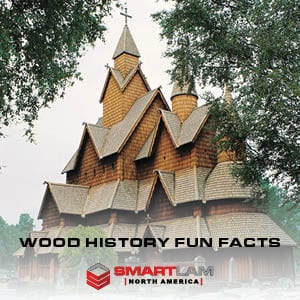
QUICK FACTS
+ Built from the Viking Era (793-1066ad) through roughly 1350 AD
+ Notre Dame was finished in 1345
+ Most are 800+ years old
+ Norwegian tree prepartion is credited for the longevity
One of the most frequent comments we get in the Mass Timber industry from people just learning about it is “Isn’t a concrete building stronger? Surely wood doesn’t last that long!” Well we are starting a new blog series on some of the oldest wood building still standing, starting today with Stave Churches, primarily found in Norway. It is estimated there were somewhere around 2,000 churches built, with roughly 30 still standing around the world.
Stave churches were built from around 1000 AD and on, however not until around 1100 did the builders start adding stone foundations, which helped dramatically in reducing the rot from the wood being directly in the ground.The stave churches that remain today are from this period of time (1150-1350 AD) although there are numerously archaeological excavations that have shown the older styles, in addition to written sources talking about these buildings. (1)
The construction of these churches involved a Norwegian wood preparation process starting from the very beginning walking the many forests of Norway (40% of Norway is forest) and picking an area of trees based on a number of factors. For example, pine is preferred, but Norwegian spruce is also good. Picking trees that were tall, straight and even, preferred from a south-facing slope. They tried to source as much as possible from a similar area to ensure consistency.
The best way to ensure the wood was really well prepared included years of preparation. “Along with the branches, the top was cut off – to limit the transport of fluid through the wood. Then, the bark was removed – all around the trunk – slightly less than one metre per year – starting from the bottom; preferably during the frost season. To get the best result, this process continued for seven years or more. By damaging the trunk in this way, the tree filled all parts of the wood with resin, trying to repair itself. The finished result – often referred to as ore-pine or cured pine – is the material that you usually find in the many ancient wooden buildings – in Norway and in other places around the globe. Wood that will last for a thousand years and more.” (6)
As a great comparison to the age of the structures, Notre Dame was completed in 1345, and Borgund Stave Church in Norway was 450 years old when St. Peter’s Basilica was consecrated.
For some extra fun, Heddel Church (pictured above) has a fun legend about the construction of the building involving trolls and five farmers finishing the whole building in three days. (2) If you’d like to see one in person but can’t make it all the way to Norway, there is a Scandinavian Heritage Park in Minot, North Dakota with a life-size replica of the Gol Stave Church in Norway. (7)
SOURCES
(1) https://en.wikipedia.org/wiki/Stave_church#cite_note-Anker-5
(2, photo) https://en.wikipedia.org/wiki/Heddal_Stave_Church
(3) https://www.visitnorway.com/typically-norwegian/stave-churches/
(4) https://ofri.com/blog/norwegian-wood-lasts-and-lasts-very-old-churches
(5) https://talknorway.no/vintage-photos-the-stave-churches-norway/
(6) https://talknorway.no/wooden-buildings-one-thousand-years-old-norway/
